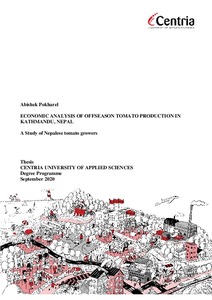Economic analysis of offseason tomato production in Kathmandu, Nepal : A Study of Nepalese tomato growers
Pokharel, Abishek (2021)
Pokharel, Abishek
2021
All rights reserved. This publication is copyrighted. You may download, display and print it for Your own personal use. Commercial use is prohibited.
Julkaisun pysyvä osoite on
https://urn.fi/URN:NBN:fi:amk-2021053112764
https://urn.fi/URN:NBN:fi:amk-2021053112764
Tiivistelmä
In Nepal, fresh seasonal and off-seasonal vegetables have been considered high value crops and commercial production of fresh vegetables is promoted. Tomato is one of the most commonly produced vegetables in Nepal. The cultivation of tomato in offseason has been gaining popularity as it fetches more price than seasonal production of tomato. But the domestic production of tomato is not enough to meet the demand during the lean period. Many efforts have been made on the growth of off-season tomato production but still it is facing problems which have disturbed the rapid expansion of tomato cultivation on sustainable way.
Generally, farmers are forced to dispose their produce at low price. Hence it is very urgent to identify different marketing and production constraints to boost-up the profitability. This study, therefore, intended to fill the gap in knowledge by surveying the condition of off-season vegetable growers and provide insights about cost, return and market of off-season tomato cultivation. The objective of the thesis was to assess the economics of offseason tomato production in Kathmandu, Nepal. Further analyses were conducted regarding the cost of production and returns of tomato production inside green house, marketing channel of offseason tomato production and identification of the major constraints of tomato production inside green house.
The research was done using quantitative methods. The data were collected through phone interviews with thirty off season tomato cultivators. The desired outcome of the thesis was to know the economics of off-season tomato cultivation and to make suggestions to the producers based on data analysis. All of the study areas (Tokha, Tarkeshwor and Budhanilkantha municipality) were found to be the potential production pocket area for tomato cultivation due to climate and edaphic suitability as well as market access. Gross margin analysis showed that tomato cultivation was one of the profitable enterprises, which was supported by its high B/C ratio. The marketing channel of produce-wholesaler-retailer-consumer had been the mostly followed channel by farmers. During the marketing of tomato, farmers faced many problems like problem during transportation, lower price of produced vegetable, problem of middleman who takes more marketing margins that increases the price of tomato in market. Due to the lower price of the tomato, farmers left vegetable in field for decay. This problem hinders farmers to cultivate offseason tomato on commercial basis.
Generally, farmers are forced to dispose their produce at low price. Hence it is very urgent to identify different marketing and production constraints to boost-up the profitability. This study, therefore, intended to fill the gap in knowledge by surveying the condition of off-season vegetable growers and provide insights about cost, return and market of off-season tomato cultivation. The objective of the thesis was to assess the economics of offseason tomato production in Kathmandu, Nepal. Further analyses were conducted regarding the cost of production and returns of tomato production inside green house, marketing channel of offseason tomato production and identification of the major constraints of tomato production inside green house.
The research was done using quantitative methods. The data were collected through phone interviews with thirty off season tomato cultivators. The desired outcome of the thesis was to know the economics of off-season tomato cultivation and to make suggestions to the producers based on data analysis. All of the study areas (Tokha, Tarkeshwor and Budhanilkantha municipality) were found to be the potential production pocket area for tomato cultivation due to climate and edaphic suitability as well as market access. Gross margin analysis showed that tomato cultivation was one of the profitable enterprises, which was supported by its high B/C ratio. The marketing channel of produce-wholesaler-retailer-consumer had been the mostly followed channel by farmers. During the marketing of tomato, farmers faced many problems like problem during transportation, lower price of produced vegetable, problem of middleman who takes more marketing margins that increases the price of tomato in market. Due to the lower price of the tomato, farmers left vegetable in field for decay. This problem hinders farmers to cultivate offseason tomato on commercial basis.
